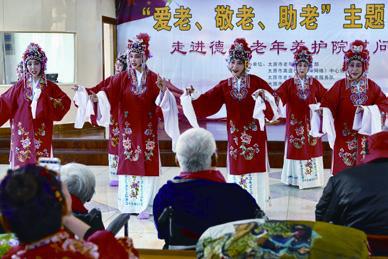Elderly Fun
2019-02-14

Elderly Fun
Amateur opera singers perform at a senior care center in Taiyuan, north Chinas Shanxi Province, on January 14.
Life-Saving Donations
The number of donations of Hematopoietic stem cells (HSC) in China in 2018 reached a record annual high of 913, up 13.7 percent year on year, the China Marrow Donor Program (CMDP) said on January 15.
Thirty-three of the donations were made for patients outside the Chinese mainland, according to the CMDP, a non-profi t organization created to regulate and administer unrelated HSC donor recruitment in China.
HSC are stem cells that give rise to all blood cell types. They are found in the bone marrow of adults and used to treat blood diseases such as leukemia.
As of the end of 2018, 2.65 million people were registered with the CMDP as potential HSC donors and a total of 7,915 donations were made, including 317 for patients outside the Chinese mainland.
Charity Work
China is home to 5,355 registered charity organizations as of January 11, according to the Ministry of Civil Affairs.
The number has more than doubled compared to September 2017, when only 2,142 such organizations were registered at civil affairs departments in the country.
In the fi rst half of 2018, 3.57 billion people participated in online charity campaigns, Vice Minister Gao Xiaobing said at an annual charity conference in Beijing on January 15.
According to a report released by the China Charity Alliance in September 2018, China received donations amounting to 149.9 billion yuan ($22.1 billion) in 2017, a 7.68-percent increase year on year.
Chinese charity groups can play a bigger role in 2019 as the country plans to lift 10 million rural residents out of poverty, Gao said.
Online Fraud Bust
The police have nabbed 36 suspects in a series of fraud cases targeting middle-aged and elderly people on the Internet, said the Ministry of Public Security (MPS) on January 15.
The suspects were accused of luring victims into joining fake poverty-reduction foundations and science projects with forged documents and stamps that looked offi cial.
Chen Shiqu, Deputy Director of the Criminal Investigation Bureau under the MPS, said the fraud rings specifi cally targeted their victims—most of whom were middle-aged and elderly—by setting up group chats on popular messaging plat- forms such as WeChat and posting false information.
Chen also warned the public to watch out for false information posted on the Internet and on smartphone applications.
The police did not reveal how much money was swindled out of the victims, but a total of 2.73 million yuan ($404,000) involved in the cases was frozen.
Doctors Grow
China now boasts a medical body of 4.5 million practitioners, up 2.7 million from 1978, according to the Chinese Medical Doctor Association on January 14.
The country has reversed its once dire medical service situation and its medical technology is now at a similar level as that of developed countries, Zhang Yanling, president of the association, said at its 2019 annual conference.
He added that the country has established a system to provide resident doctors with proper training after they graduate from medical school, so as to improve the quality of medical service.
The standardized training programs enable medical school graduates to practice their professional techniques in hospitals that are set up as training bases.
In 2018, a total of 62,000 resident doctors underwent tests on their professional skills, including 15,000 traditional Chinese medicine practitioners, Zhang said.
National Park Plan
China will push forward the construction of pilot national parks and draw a general plan for the development of national parks this year, according to the countrys forestry authorities.
The country will also formulate standards for building national parks, consolidate management and operation of pilot parks and conduct a comprehensive assessment of these parks, the National Forestry and Grassland Administration said in a statement.
The construction of 10 pilot national parks made steady progress in 2018, the statement said. The administrations of the Giant Panda and Qilian Mountain national parks were inaugurated. The general plan for the Northeast China Tiger and Leopard National Park was fi nished, the plan for the Sanjiangyuan National Park approved, and the proposal for the Hainan Tropical Rainforest National Park has been submitted for approval.
Meanwhile, a research center for national park planning was established in southwest Chinas Yunnan Province in 2018 to facilitate the protection of nature reserves.
This year, general plans for the Giant Panda and Qilian Mountain national parks will be compiled, and together with the Northeast China Tiger and Leopard National Park plan, will be submitted for approval.
The compilation of a general plan for the Hainan Tropical Rainforest National Park will begin in 2019.
In addition, the administration will draft regulations for the management of natural resources and patrols at national parks, the statement said.
Under a plan released in 2017, China aims to set up a batch of national parks and form a unifi ed management system by 2020.
Back to the Wild
Workers release a whooper swan into the Poyang Lake National Natural Reserve in east Chinas Jiangxi Province on January 14. In total, 16 rare migrant birds were released into the wild during the activity.
Xinjiangs Development
Support funds totaling about 16 billion yuan ($2.37 billion) were allo- cated to northwest Chinas Xinjiang Uygur Autonomous Region in 2018, offi cial data showed.
The funds, from 19 provinces and cities, were allocated to help local residents rise out of poverty and improve their livelihood, Shohrat Zakir, chairman of the regional government, said in a work report to Xinjiangs legislature on January 14.
In 2018, authorities with these provinces and cities also helped train talent for Xinjiang, offered jobs to Xinjiang residents in developed areas and enhanced communication, Shohrat Zakir said.
Xinjiang will continue to learn from other provinces and cities and allocate support funds to improve peoples livelihood and communitylevel areas, he said.
Less Traffic Accidents
The number of serious traffi c accidents resulting in 10 or more deaths decreased 44.4 percent year on year to just fi ve in 2018, the Ministry of Public Security said on January 15.
The death toll in traffi c accidents dropped to 578, or 0.9 percent, from 2017 to 2018, while no accident caused 30 deaths or more, the ministry added.
The country has registered 240 million automobiles, with licensed drivers reaching 409 million.
Although it attributed the reduction in deaths to a series of national campaigns against reckless driving, the ministry warned that there were still a large number of substandard vehicles and loopholes in monitoring networks, and that public awareness needed to be improved. The ministry pledged more campaigns to screen loopholes and push transport industries and enterprises to improve their internal regulations.
Paper Works
Students learn how to make handmade paper from pressed fl owers in Wanda Town in Danzhai County, southwest Chinas Guizhou Province, on January 10. Many visitors from China and abroad learn traditional techniques such as batik and papermaking in Danzhai each year.

Rural Healthcare
China will advance poverty alleviation in healthcare and ensure all medical institutions at county, township and village levels in impoverished areas reach set standards by 2020, according to the National Health Commission.
Hu Qiangqiang, a spokesperson for the commission, said on January 10 that higher-level hospitals in China will help their countylevel counterparts in poor regions with talent building, with each township-level institution set to have one general practitioner by 2020.
Telemedicine services will cover all township-level hospitals in poor regions. Screening for breast and cervical cancers for rural women and screening for newborns in poor areas will make further progress, Hu said.
Incentives will also be raised for medical professionals working at community-level hospitals, Hu added.
More Tax Cuts
Taxes and fees will be cut on a larger scale this year to ensure sustained and healthy economic development, Assistant Finance Minister Xu Hongcai said at a press conference on January 15.
The government will unveil favorable tax policies to support small and micro businesses and deepen value-added tax reform. Burdens on the manufacturing sector as well as small and micro companies will be lessened. The fi scal expenditure will be moderately expanded and fi nancial input increased in areas like poverty alleviation, technological innovation and environmental protection.
Zhu Hexin, Deputy Governor of the Peoples Bank of China, said the central bank will offer fi nancial support for the real economy, avoid a fl ood of liquidity and maintain a stable macro-leverage ratio.
Maintaining a prudent monetary policy, however, does not mean the central bank cannot tweak its policies, Zhu added. Policies will be fi netuned to make them more forwardlooking, fl exible and targeted whenever necessary.
Lian Weiliang, Vice Minister of the National Development and Reform Commission, said investment will be made more targeted and effective, and massive economic stimuli will be avoided.
Investment will be increased with a focus on construction and renovation, prioritizing areas like artifi cial intelligence, the industrial Internet, the Internet of Things and major infrastructure projects, according to Lian.
Festival Preparation
Workers assemble components at a locomotive maintenance center in Ulanqab, north Chinas Inner Mongolia Autonomous Region, on January 15. Extensive maintenance for the key parts of locomotives was carried out before the Chinese Lunar New Year travel rush starting on January 21.

Industrial Output
Chinas value-added industrial output, an important economic indicator, expanded 6.3 percent year on year in the fi rst 11 months of 2018. It was higher than the 6-percent annual target, Xin Guobin, Vice Minister of Industry and Information Technology, told a press conference on January 16.
“Even if the industrial growth rate remained slow in December 2018, China can ensure that the full-year target will be achieved,” Xin said.
Major industrial fi rms profi ts grew 11.8 percent year on year in the same period.
Industrial growth was kept within a reasonable range and the actual result was better than expected, according to Xin.
The value-added industrial out- put is expected to hit 30 trillion yuan($4.4 trillion) in 2018, the highest in the world.
China will maintain its leading role as a manufacturer of more than 220 major industrial products with the worlds most comprehensive industrial system.
In the fi rst 11 months of 2018, the hi-tech manufacturing sector grew 13.6 percent year on year, raising its share in the overall value-added industrial output to 13.6 percent.
Housing Prices
Housing prices in major Chinese cities remained stable in December 2018 as local governments largely continued market regulation, National Bureau of Statistics (NBS) data showed on January 16.
On a monthly basis, new house prices in 59 of the 70 major cities tracked by the NBS rose, down from 63 a month earlier. Eight cities reported lower prices while three saw prices unchanged.
New house prices in Beijing, Shanghai, Shenzhen and Guangzhou rose 1.3 percent in December 2018, up 1 percentage point from the previous month. Resold house prices in the four megacities fell 0.3 percent on average.
NBS senior statistician Liu Jianwei said local governments maintained differentiated real estate policies to maintain stable and sound development of the property market.
On average, new house prices in the four megacities edged up 0.5 percent in 2018, shrinking from the 10.1-percent gain during the same period a year earlier. Growth of resold house prices also saw a signifi cant slowdown.
Large cities generally followed the trend, while medium-sized cities registered vigorous price increases.
Investment Quota
Chinas forex regulator announced on January 14 that the total quota of the Qualifi ed Foreign Institutional Investors (QFII) program had doubled to $300 billion, a new step to open up the capital market.
The move aims to meet demand from overseas investors to expand investment in Chinas capital market, the State Administration of Foreign Exchange (SAFE) said in a statement.
The QFII program is the earliest and most important arrangement for the opening up of the countrys capital market, the statement said.
Introduced in 2003, the scheme allows overseas institutional investors to move money into Chinas capital account to encourage controlled fl ows.
By the end of 2018, the country had approved a total QFII quota of about $101 billion.
A New Picture
Li Zhicheng, a rural photographer, exhibits his images of the local winter landscape in Erhe Town in Shulan, northeast Chinas Jilin Province, on January 10. The remote town has begun attracting an increasing number of tourists in recent years with the development of winter-themed tourism.
SOE Profits Up
Chinas centrally administered stateowned enterprises (SOEs) saw strong revenue and profi t growth in 2018, offi cial data showed on January 15. Despite rising economic uncertainty, central SOEs reported profi ts of 1.7 trillion yuan ($251.7 billion), up 16.7 percent year on year, according to the State-Owned Assets Supervision and Administration Commission of the State Council.
The combined revenues of the 96 centrally administered SOEs increased 10.1 percent year on year to 29.1 trillion yuan ($4.3 trillion).
Industrial companies, with net profi ts surging 21.3 percent, contributed 67.4 percent of the total net profi t growth of centrally administered SOEs.
In 2018, the debt-to-asset ratio of centrally administered SOEs stood at 65.7 percent, 0.6 percentage point down from a year earlier.
Steel Reform
Chinese steel producers saw their profi ts surge in the fi rst 11 months of 2018 as the sectors overcapacity was slashed amid supply-side structural reform, China Iron and Steel Association (CHINAISA) data showed.
The combined profi ts of CHINAISAs member enterprises jumped 63.54 percent year on year to 280.2 billion yuan ($41.5 billion) in the fi rst 11 months of 2018.
Their debt ratio declined to 65.74 percent by the end of November 2018, down 3.39 percent- age points from a year earlier, with half of the enterprises seeing a debt ratio of below 60 percent.
The improvement in corporate profi tability came after the goal of reducing the steel industrys capacity by 100 million to 150 million tons by 2020 was met ahead of schedule.
By the end of 2017, overcapacity had been slashed by over 115 million tons.
“The market environment has improved markedly, and the bloated capacity has been effectively addressed,” CHINAISA Chairperson Yu Yong said.
However, Yu cautioned that the foundation for sustained profi tability remained shaky as costs increased while steel prices retreated due to lower demand and growing output.
Colorful Options
A tourist eyes a scarf at the Grand Bazaar Pedestrian Mall in Urumqi, capital of northwest Chinas Xinjiang Uygur Autonomous Region, on January 12.
According to statistics by the Culture and Tourism Bureau of Tianshan District of Urumqi, the number of visitors to the Grand Bazaar Pedestrian Mall has reached 14.12 million since its opening in August 2018.
Microsoft Lab
U.S. tech giant Microsoft has signed a memorandum of strategic cooperation to set up its new artifi cial intelligence (AI) and Internet of Things(IoT) Insider Lab, the fi rst of its kind in the Asia-Pacifi c region, in Shanghai.
The memorandum was signed between the company and Shanghais Pudong New Area on January 16. The lab is expected to open in April.
It will be Microsofts third and largest AI and IoT Insider Lab in the world after the company set up the fi rst two in Seattle and Munich, Germany.
The lab is set to enhance deep integration of AI and IoT, and help digital transformation across industries including manufacturing, retail, healthcare and the public sector.
“China has the worlds largest IoT market. The AI and IoT industry has great potential in China,”said Roan Kang, Vice President of Microsoft China, adding that Microsoft would provide the most comprehensive AI and IoT platform, products and solutions.
The lab will work with local enterprises and multinational companies to build prototypes through production, conduct technical training and provide go-to-market advisory and deployment and scalability guidance, the company said.
